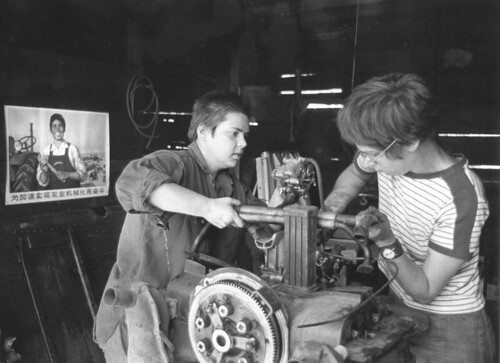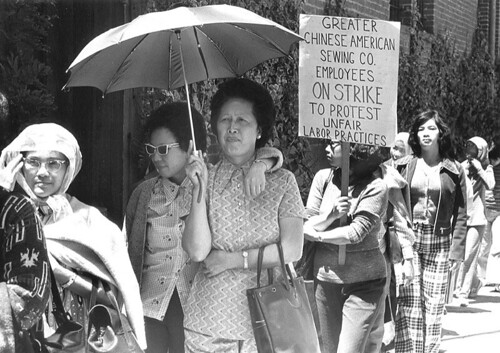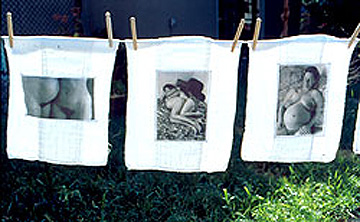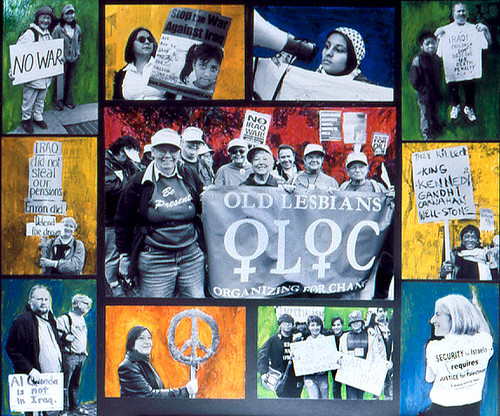Cathy became an activist while she was in college: in 1966 she joined the Civil Rights Movement, demonstrating and organizing with SNCC. As an opponent of the Vietnam War, she helped found the Tulane chapter of SDS, and later was an early actor in the Women's Movement. In 1970, Cathy moved to San Francisco where she soon came out as a lesbian and started taking pictures, and her interconnected dedication to social justice and to photography has persisted throughout her life. Along with her documentary photo projects, Cathy runs a business as a professional photographer and personal historian. (Her website has details.) I was so excited when Cathy agreed to do an interview with me, and not only did we have a great time talking, but she managed to recruit me to a whole pile of women's history related projects she's involved with!
Along with the interview, I asked Cathy to chose a few pictures which show how her work has changed over the years. You can find them below, each with a little bit of background from her in the caption.

Gail Grassi and Kate Kaufman repairing a car. "It was a time when we all looked to the Chinese Revolution for progressive ideas of making the world a better place for people."
Bay Radical You talked before we started taping about how when you first started doing photography, you couldn't believe that women could really use that equipment.
Cathy Cade That's right.
BR You started taking pictures in '71 – is that right?
CC Ya. The same spring I came out as a lesbian; they were very connected. It was a time when a lot of lesbians were getting into the trades. And so one of the first things I did was photograph women in the trades, and photograph my friends tuning their cars, and the Women's Press Collective printing books, and carpenters. I still like to do that. Recently I've been photographing men doing skilled work. Uptown Body and Fender is in downtown Oakland and the woman who owns that loves art and she hired me to photograph her workers. [Now] there are these big beautiful black and white prints up on the wall, so when you've had your car smashed up you drive in there and you get out of your car and here are all these skilled mechanics doing their work.
BR That's really cool.
CC It turns out I like to photograph men doing skilled work also.
BR Have you taken pictures of men over the years?
CC Some gay men. But this is all political. Most of the men who work in that shop are immigrants from Latin America, one of whom was just being deported the other day. So it all stays political.
BR Was there some lag between when you started taking pictures and when you started thinking of yourself as a photographer?
CC Not very much, but it's a good question because one of the reasons I started taking pictures was because I was tired of going to meetings and all the processing and yet I still wanted to be in the movement. I figured I could make my contribution and not have to go to so many meetings. When I started photographing there were all these new magazines, and there [were] new exhibit opportunities because the women's movement and the lesbian feminist movement was just bursting out. And so my work got used right away. There wasn't any long period of me wondering if anybody was going to like my work or anything. It was totally grabbed up and used in newspapers, and magazines, and local exhibits, and in the new coffeehouses, so that made it really easy.
I didn't want to use the word "artist" because when I was growing up an artist was one of these rare people who was born with humongous talent and "please don’t embarrass us by thinking that you might be talented". But there were people like Holly Near and others using the word "cultural worker", so I could call myself a cultural worker. Things have changed over the years and I call myself an artist. And I'm glad to identify as an artist, but the fact that I was starting to do my photo work when it was wanted, needed, used and I could call myself a cultural worker – was helpful!

"I became involved with a coalition of union women called Union WAGE - Union Women's Alliance to Gain Equality. Some of the leadership were of an older generation than we were and had been activists in the '30s. This was one of the only places in the '70s where women in the women's movement of different generations were connecting with each other."
BR Right. That makes sense.
CC I didn't get paid.
BR Right. [Laughing] Some things don't change.
CC I think that I worked in photography as opposed to film partly because I could take pictures without having to raise a lot of money. My attitude a lot was, "You can't stop me." With a camera and wanting to take pictures and maybe wanting to get them out a little bit, the "you can't stop me" would work.
Now a days with the new technology you probably can make little films and put them up on YouTube, that's probably shifted.

"I wanted to do a book on lesbian mothering but I never got to, and when I couldn't do a book I said 'I'm going to take some of my favorite images, and I'm going to print them on cloth and embroider the cloth onto diapers'. The great thing about it is, I hang it up on a clothes line with old fashioned clothes pins - I can hang up an exhibit in 20 minutes - which means that I can hang it up for a one day event. I have it in the works to expand it."
BR Right. Well, it's a trade off because, what we don't have now is a movement to go with it and so it's…
CC You don't think we do?
BR Well, I'm curious how you think about it because your work was such a part of a movement. Does it still feel like its connected to a movement in the same way?
CC Well, backup a minute. I had two kids as a lesbian by donor insemination. My first son was born in '78, and my second in '85 – this was the beginning of this new lesbian mothering movement – so I had my kids and raised my kids in a political context. There were those years where lesbian mothering was my movement. After they got to a certain age, I guess high school or something, they weren't around as much and I started looking around and saying, "OK, so where's the Women's Movement? Where's the Lesbian Movement now?" And I couldn't find it. At first it seemed like it was nowhere. Like, when I moved out here in '71, I knew where the Women's Liberation Movement was: it was at Glide Church on Friday nights at 7:30.
BR That makes it easy!
CC Ya! But then we're talking the late '80s, early '90s, it's like nowhere and everywhere. And that's what it feels like now. But I'm now more and more connected with an old lesbian movement, and that's easier to identify - where it is - so I've lucked out again, in another identifiable movement.

Old Lesbians Organizing for Change marching at an early anti-Iraq War demonstration. "I started cutting up my pictures and making collages. This was radical. I had all been black and white, documentary photography, and all the sudden I'm cutting up a print and I'm going, 'Who do you think you are? God?'"
BR [There's a] theme that I see in your pictures that I wondered if you see, or if you have other themes that you want to point out: The subjects in your pictures are without self-consciousness, and especially because it's women doing non-traditional work, or people who are seen by the outside world as ugly in a certain way, that you just present in this really matter-of-fact way.
CC Well, I really appreciate you calling it that because some people think I'm overly positive, disgustingly positive, just this old Pollyanna, so it's nice of you to call it self-acceptance and a lack of self-consciousness. But I really did want to show us as human beings and to show us acting out of our personal power. Those early women in the trades pictures have a lot of sense of personal power you know. And I wanted to show women as smart and loving.
And the lesbian mothering pictures, I called them "mothering" not just "lesbian mothers" because nobody talked about mothering and what a job [it] was, and that it had skills. Part of what I wanted to do in those pictures was to articulate, "What do mothers do?" Not just what do lesbian mothers do but, "What is the job of mothering?"
The other thing is the everydayness - celebrating the everydayness. Everyday activities and everyday people.

"These quilt photos start out being 4X6 color prints that I take to the lab and they make 'em. No more sweating in the dark room. I cut the prints up and I reassemble them like you would a quilt if you had little pieces of cloth. They're about beauty, and I think in this day and age beauty brings hope, and getting to have hope is very political."

3 comments:
Fantastic! I love how CC says that she wanted to find a way to stay involved but get out of the processing and meetings. Super smart! I will now think of myself as following in her meeting-avoidant footsteps!
Thank you for this! Great interview, and inspiring photos. I love Cathy's "You can't stop me" attitude. :)
Love,
Eeni B. Bella (commenting as "anonymous" 'cause I can't figure out how to sign in with my Wordpress name!)
Thanks for visiting Eeni. As it turns out, Cathy is wonderful in person too!
Post a Comment